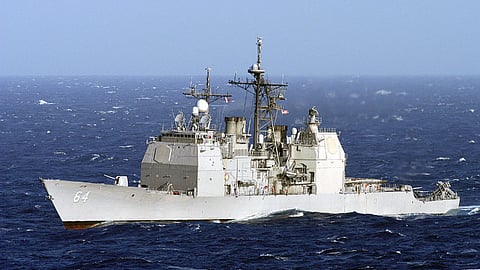Government Accountability Office report reveals poor planning behind US Navy cruiser modernisation program
The US Navy has spent US$3.7 billion to modernise its Ticonderoga-class guided-missile cruisers to extend their service lives rather than retire them, the US Government Accountability Office (GAO) said in a recently published report.
The effort has been plagued with problems like schedule delays, wasted costs, and poor quality work. Only three of 11 cruisers will complete the modernisation process and they won't spend as much time at sea as intended. None of the ships will gain five years of service life, as intended.
The GAO said the navy wasted US$1.84 billion modernising four cruisers that have now been divested prior to deploying.
The navy also experienced contractor performance and quality issues across the cruiser effort. For example, the contractor performed poor quality work on USS Vicksburg's sonar dome, resulting in additional cost and schedule delays due to necessary rework.
The GAO commented that the navy did not effectively plan the cruiser effort. This led to a high volume of unplanned work – 9,000 contract changes – resulting in cost growth and schedule delays.
The navy has yet to identify the root causes of unplanned work or develop and codify root cause mitigation strategies to prevent poor planning from similarly affecting future surface ship modernisation efforts.
Also, weakened quality assurance tools restricted the navy's ability to hold contractors accountable for poor quality work. In 2018, leadership restricted maintenance officials from assessing monetary penalties to contractors without senior leadership approval.
In 2020, leadership changed procedures to reduce inspections, which are a vital tool for overseeing ship repair contracts, by almost 50 per cent. These actions were implemented to maintain strong working relationships with the contractors because of the navy's dependence on them to modernise its fleet, according to navy officials.
Without reassessment, the navy risks experiencing similar negative outcomes in future modernisation efforts.
Why the GAO did this study
In 2012 and 2013, the navy proposed retiring several cruisers due to budget constraints. Congress rejected the navy's proposal and provided funding to modernise these ships.
In response, the navy planned to use a phased approach to modernisation that would extend 11 cruisers' service life by five years and upgrade the vessels' combat capability. The navy originally planned to complete all 11 cruisers by fiscal year 2026.
The navy has other upcoming significant surface ship modernization efforts, such as for 23 destroyers. The success of these efforts is critical to the navy having a combat-ready fleet.
A Senate report included a provision for the GAO to assess the navy's cruiser modernization. This report assesses, among other things, the extent to which (1) the navy met its modernisation objectives; (2) the navy's planning affected outcomes; and (3) the navy exercised effective quality control and oversight of the effort.
To do this work, the GAO toured five cruisers undergoing modernisation, interviewed over 100 navy officials, compared actual versus planned cost and schedule data, and reviewed navy documentation and prior GAO reports related to navy shipbuilding and repair.
Recommendations
The GAO is making six recommendations, including that the navy assess root causes of unplanned work, develop mitigation strategies, and codify these strategies in policy; and re-assess its overall approach to quality assurance to prevent similar issues in future surface ship modernisation efforts. The navy has concurred with all six recommendations.


